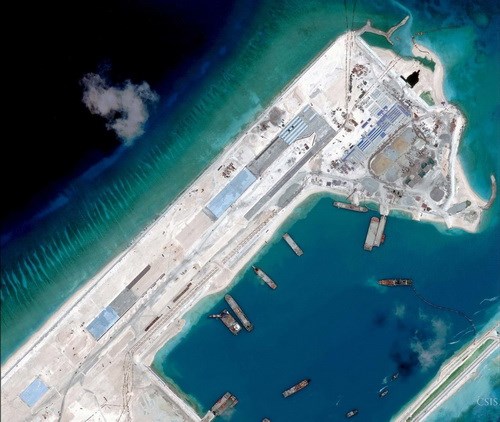VietNamNet Bridge – An "exclusive order" is being formed in the East Sea (South China Sea), and it is challenging the freedom and safety of navigation and aviation for the entire world, Dr. Truong Minh Huy Vu, director of the Centre for International Studies (SCIS), HCM City University of Social Sciences and Humanities, said in a talk with VietNamNet.
 |
| A satellite photo of China's facilities on the reef of Chu Thap (Fiery Cross) in Vietnam's Truong Sa Archipelago (Spratly Islands). |
The reclamation and expansion of reefs into artificial islands as well as the building of mobile islands for different purposes is considered the next step of China in the process of establishing an "exclusive order" in the East Sea. Dr. Vu commented on the formation, the characteristic and the consequences of this order for regional security situation, as well as the upcoming scenarios behind the hardening reaction of USA.
The test
Since 2009, China has conducted a series of "tests", from "gentle ones" such as harassment of fishing vessels of other claimants; cutting telecom cables; imposing fishing bans; prohibiting foreign companies from exploring and exploiting oil and gas; to more serious acts as encroaching the Scarborough or deploying the HD-981 drilling rig in the exclusive economic zone of Vietnam. In 2015, when the photos of artificial islands were revealed, the public raised the question: What is happening in the East Sea through Beijing’s moves?
The move by China can be summed up in these words: Building an exclusive order. The characteristic of this order is selective, open and closed based on the rules and principles set by a powerhouse. That process has been taking place for years, but it started moving rapidly from 2009.
In this year, after the crash between the Impeccable Class Ocean Surveillance Ship of the US with Chinese patrol boats in the waters that is 120 km from Hainan Island, the first concerns emerged about the maritime order established by the US after the World War II being challenged by the rise of China. The most important pillar that is threatened is the principle of freedom of navigation, with the view of the "open ocean," which is not exclusively owned by any country.
In the subsequent years, Beijing tried to disguise the "militarization" trend to set the rules of the game in the disputed areas through the “small acts” (harassment of fishing vessels of other claimants; cutting telecom cables; imposing fishing bans; prohibiting foreign companies from exploring and exploiting oil and gas) that were conducted regularly over a long period so as to not “shock" others.
In 2015, what is happening in the field in the East Sea is no longer a challenge, but has gradually become reality. The building of artificial islands can be seen as the latest and most serious step of China to assert its power and ownership over the East Sea.
An "exclusive order" is being formed, and it is challenging the freedom and safety of navigation and aviation of the whole world. Not only because of the importance of the East Sea as a lifeline of the global maritime ... but more importantly, it is how a superpower rising to rewrite the world rules unilaterally, accompanied by force.
Why we call the order that China is building an "exclusive order"?

First, the order that China is forming in the East Sea creates more and more clear borders in the field. The "Great Walls in the sea" are being established by the islands that China are rapidly building, accompanied with surrounding waters. It is being formed not through the interpretation of the 1982 UN Convention on the Law of the Sea (UNCLOS). Discussions have been drawn into two different issues, including the maritime rights relating to the exclusive economic zones (EEZ) and the sovereignty of the islands in relation to territorial waters.
For the maritime rights, only "islands" and not "reefs" have the 200 nautical mile EEZ. That is the focus of the debate around the difference between the "island" and the "reef" under Article 121 of UNCLOS. To get the 12 nautical mile territorial waters, the reefs must meet certain criteria under UNCLOS, and they must be located above the water at high tide.
The issue is more complicated because the territorial delineation rights are not based on the current status of the territory, but territorial sovereignty.
Second, China's order is based on the concept of ambivalence about the perspective of freedom of navigation. On one hand, China said that they respect and comply with the terms of UNCLOS on "passing with no harm". But the explanation from China also repeatedly argued that the “passing with no harm” in the waters of 200 nautical miles from the baselines must be controlled or subject to the consent of the coastal state to not harm sovereignty and national security.
Basically, the argument that the military monitoring activities may be limited within the EEZ of a coastal state is often based on two pillars. One is the assumption that the aforementioned military operations aim at "peaceful purposes" - a concept that is not defined in detail in UNCLOS. Two, the use of a number of monitoring technologies aimed at "marine scientific research" - another vague concept in UNCLOS, but it is a concept that coastal states can legislate in their EEZ. Thus, rather than clarify ambiguous points in UNCLOS, China takes advantage of this "vagueness" to "eliminate" the free movement of boats of other nations.
Third, does the pursuit of a concept of restrictive freedom of navigation or building "Great Walls on the sea" of Beijing target creating new international practices, in which the East Sea is a test?
Quoc An